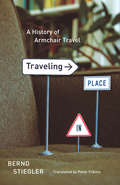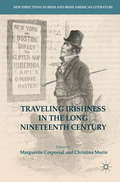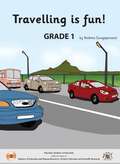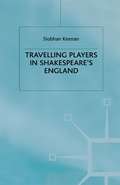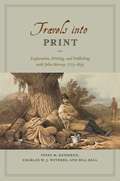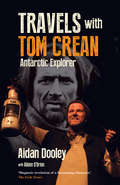- Table View
- List View
Traveling Bodies: Interdisciplinary Perspectives on Traveling as an Embodied Practice (Routledge Research in Travel Writing)
by Nicole Maruo-Schröder, Sarah Schäfer-Althaus, and Uta SchaffersTraveling Bodies: Interdisciplinary Perspectives on Traveling as an Embodied Practice explores the central role the body has in and for traveling and thus complements and expands upon existing research in travel studies with new perspectives on and insights in the entanglement of bodies and traveling. The case studies assembled in this volume discuss a variety of traveling practices, experiences, and media with chapters featuring Asian, American, and European historical and contemporary perspectives. Truly interdisciplinary in its approach, the volume identifies and examines diverse literary, historical and cultural texts, contexts, and modes in which traveling and the body intersect, including ‘classic’ travelogues, (new) media (e.g., film, digital travel apps), surf culture, and travel-inspired tattoos. The contributions offer various avenues for further research, not only for scholars working with body theory and travel (writing), but also for anyone interested in the intersections of literature, culture, media, and embodied practices of traveling.
Traveling in Place: A History of Armchair Travel
by Bernd StieglerArmchair travel may seem like an oxymoron. Doesn’t travel require us to leave the house? And yet, anyone who has lost herself for hours in the descriptive pages of a novel or the absorbing images of a film knows the very real feeling of having explored and experienced a different place or time without ever leaving her seat. No passport, no currency, no security screening required—the luxury of armchair travel is accessible to us all. In Traveling in Place, Bernd Stiegler celebrates this convenient, magical means of transport in all its many forms. Organized into twenty-one “legs”—or short chapters—Traveling in Place begins with a consideration of Xavier de Maistre’s 1794 Voyage autour de ma chambre, an account of the forty-two-day “journey around his room” Maistre undertook as a way to entertain himself while under house arrest. Stiegler is fascinated by the notion of exploring the familiar as though it were completely new and strange. He engages writers as diverse as Roussel, Beckett, Perec, Robbe-Grillet, Cortázar, Kierkegaard, and Borges, all of whom show how the everyday can be brilliantly transformed. Like the best guidebooks, Traveling in Place is more interested in the idea of travel as a state of mind than as a physical activity, and Stiegler reflects on the different ways that traveling at home have manifested themselves in the modern era, from literature and film to the virtual possibilities of the Internet, blogs, and contemporary art. Reminiscent of the pictorial meditations of Sebald, but possessed of the intellectual playfulness of Calvino, Traveling in Place offers an entertaining and creative Baedeker to journeying at home.
Traveling in Place: A History of Armchair Travel
by Bernd StieglerArmchair travel may seem like an oxymoron. Doesn’t travel require us to leave the house? And yet, anyone who has lost herself for hours in the descriptive pages of a novel or the absorbing images of a film knows the very real feeling of having explored and experienced a different place or time without ever leaving her seat. No passport, no currency, no security screening required—the luxury of armchair travel is accessible to us all. In Traveling in Place, Bernd Stiegler celebrates this convenient, magical means of transport in all its many forms. Organized into twenty-one “legs”—or short chapters—Traveling in Place begins with a consideration of Xavier de Maistre’s 1794 Voyage autour de ma chambre, an account of the forty-two-day “journey around his room” Maistre undertook as a way to entertain himself while under house arrest. Stiegler is fascinated by the notion of exploring the familiar as though it were completely new and strange. He engages writers as diverse as Roussel, Beckett, Perec, Robbe-Grillet, Cortázar, Kierkegaard, and Borges, all of whom show how the everyday can be brilliantly transformed. Like the best guidebooks, Traveling in Place is more interested in the idea of travel as a state of mind than as a physical activity, and Stiegler reflects on the different ways that traveling at home have manifested themselves in the modern era, from literature and film to the virtual possibilities of the Internet, blogs, and contemporary art. Reminiscent of the pictorial meditations of Sebald, but possessed of the intellectual playfulness of Calvino, Traveling in Place offers an entertaining and creative Baedeker to journeying at home.
Traveling in Place: A History of Armchair Travel
by Bernd StieglerArmchair travel may seem like an oxymoron. Doesn’t travel require us to leave the house? And yet, anyone who has lost herself for hours in the descriptive pages of a novel or the absorbing images of a film knows the very real feeling of having explored and experienced a different place or time without ever leaving her seat. No passport, no currency, no security screening required—the luxury of armchair travel is accessible to us all. In Traveling in Place, Bernd Stiegler celebrates this convenient, magical means of transport in all its many forms. Organized into twenty-one “legs”—or short chapters—Traveling in Place begins with a consideration of Xavier de Maistre’s 1794 Voyage autour de ma chambre, an account of the forty-two-day “journey around his room” Maistre undertook as a way to entertain himself while under house arrest. Stiegler is fascinated by the notion of exploring the familiar as though it were completely new and strange. He engages writers as diverse as Roussel, Beckett, Perec, Robbe-Grillet, Cortázar, Kierkegaard, and Borges, all of whom show how the everyday can be brilliantly transformed. Like the best guidebooks, Traveling in Place is more interested in the idea of travel as a state of mind than as a physical activity, and Stiegler reflects on the different ways that traveling at home have manifested themselves in the modern era, from literature and film to the virtual possibilities of the Internet, blogs, and contemporary art. Reminiscent of the pictorial meditations of Sebald, but possessed of the intellectual playfulness of Calvino, Traveling in Place offers an entertaining and creative Baedeker to journeying at home.
Traveling in Place: A History of Armchair Travel
by Bernd StieglerArmchair travel may seem like an oxymoron. Doesn’t travel require us to leave the house? And yet, anyone who has lost herself for hours in the descriptive pages of a novel or the absorbing images of a film knows the very real feeling of having explored and experienced a different place or time without ever leaving her seat. No passport, no currency, no security screening required—the luxury of armchair travel is accessible to us all. In Traveling in Place, Bernd Stiegler celebrates this convenient, magical means of transport in all its many forms. Organized into twenty-one “legs”—or short chapters—Traveling in Place begins with a consideration of Xavier de Maistre’s 1794 Voyage autour de ma chambre, an account of the forty-two-day “journey around his room” Maistre undertook as a way to entertain himself while under house arrest. Stiegler is fascinated by the notion of exploring the familiar as though it were completely new and strange. He engages writers as diverse as Roussel, Beckett, Perec, Robbe-Grillet, Cortázar, Kierkegaard, and Borges, all of whom show how the everyday can be brilliantly transformed. Like the best guidebooks, Traveling in Place is more interested in the idea of travel as a state of mind than as a physical activity, and Stiegler reflects on the different ways that traveling at home have manifested themselves in the modern era, from literature and film to the virtual possibilities of the Internet, blogs, and contemporary art. Reminiscent of the pictorial meditations of Sebald, but possessed of the intellectual playfulness of Calvino, Traveling in Place offers an entertaining and creative Baedeker to journeying at home.
Traveling Irishness in the Long Nineteenth Century
by Marguérite Corporaal Christina MorinExploring the effects of traveling, migration, and other forms of cultural contact, particularly within Europe, this edited collection explores the act of traveling and the representation of traveling by Irish men and women from diverse walks of life in the period between Grattan’s Parliament (1782) and World War I (1914). This was a period marked by an increasing physical and cultural mobility of Irish throughout Britain, Continental Europe, the Americas, and the Pacific. Travel was undertaken for a variety of reasons: during the Romantic period, the ‘Grand Tour’ and what is now sometimes referred to as medical tourism brought Irish artists and intellectuals to Europe, where cultural exchanges with other writers, artists, and thinkers inspired them to introduce novel ideas and cultural forms to their Irish audiences. Showing this impact of the nineteenth-century Irish across national borders and their engagement with global cultural and linguistic traditions, the volume will provide novel insights into the transcultural spheres of the arts, literature, politics, and translation in which they were active.
Traveling Irishness in the Long Nineteenth Century
by Marguérite Corporaal Christina MorinExploring the effects of traveling, migration, and other forms of cultural contact, particularly within Europe, this edited collection explores the act of traveling and the representation of traveling by Irish men and women from diverse walks of life in the period between Grattan’s Parliament (1782) and World War I (1914). This was a period marked by an increasing physical and cultural mobility of Irish throughout Britain, Continental Europe, the Americas, and the Pacific. Travel was undertaken for a variety of reasons: during the Romantic period, the ‘Grand Tour’ and what is now sometimes referred to as medical tourism brought Irish artists and intellectuals to Europe, where cultural exchanges with other writers, artists, and thinkers inspired them to introduce novel ideas and cultural forms to their Irish audiences. Showing this impact of the nineteenth-century Irish across national borders and their engagement with global cultural and linguistic traditions, the volume will provide novel insights into the transcultural spheres of the arts, literature, politics, and translation in which they were active.
Travelling Heroes: Greeks and their myths in the epic age of Homer
by Robin Lane FoxThis remarkable and daringly original book proposes a new way of thinking about the Greeks and their myths in the age of the great Homeric hymns. It combines a lifetime's familiarity with Greek literature and history with the latest archeological discoveries and the author's own journeys to the main sites in the story to describe how particular Greeks of the eighth century BC travelled east and west around the Mediterranean, and how their extraordinary journeys shaped their ideas of their gods and heroes. It gathers together stories and echoes from many different ancient cultures, not just the Greek - Assyria, Egypt, the Phoenician traders - and ranges from Mesopotamia to the Rio Tinto at Huelva in modern Portugal. Its central point is the Jebel Aqra, the great mountain on the north Syrian coast which Robin Lane Fox dubs 'the southern Olympus', and around which much of the action of the book turns. Robin Lane Fox rejects the fashionable view of Homer and his near-contemporary Hesiod as poets who owed a direct debt to texts and poems from the near East, and by following the trail of the Greek travellers shows that they were, rather, in debt to their own countrymen. With characteristic flair he reveals how these travellers, progenitors of tales which have inspired writers and historians for thousands of years, understood the world before the beginnings of philosophy and western thought.
Travelling Is Fun! class 1 - MIE
by Reshma Gungapersand"Travelling Is Fun!" unfolds the adventures of Ben, as he embarks on a journey to the airport. En route, he eagerly observes a vibrant array of vehicles, from a big red bus to motorcycles and bicycles, delighting in the unique experiences each mode of transport offers. Upon reaching the airport, Ben's excitement soars as he witnesses the swift flight of an airplane, dreaming of his upcoming journey high in the sky to England. In England, he anticipates the thrill of train travel, weaving in and out of stations, sparking his excitement even further. Through engaging illustrations and simple yet descriptive language, the book captures the allure of travel, igniting a sense of adventure and discovery in young readers.
Travelling memories: Deutschsprachige Kinder- und Jugendliteratur über die Flucht während des Nationalsozialismus und aus der DDR (Studien zu Kinder- und Jugendliteratur und -medien #15)
by Larissa Carolin JagdschianAufgrund der anhaltenden Fluchtbewegungen fordert Aleida Assmann zur Umstrukturierung national ausgerichteter Erinnerungskulturen auf, damit Flüchtlinge mehr an Erinnerungsprozessen partizipieren können. Diese Forderung greift die Studie am Beispiel der Untersuchung der topografischen und erinnerungskulturellen Darstellungen der Flucht in der Kinder- und Jugendliteratur auf, indem ein Modell des Gedächtnisses der deutschsprachigen Kinder- und Jugendliteratur entwickelt wird. Im Vordergrund stehen zwei historische Phasen: die Flucht während des Nationalsozialismus (1933–1945) und die Flucht aus der Deutschen Demokratischen Republik (1957–1989). Mit der vergleichenden Untersuchung von Exilromanen, realistischen ost- und westdeutschen Kinder- und Jugendromanen nach 1945, DDR-Mädchenromanen, zeitgeschichtlichen und geschichtserzählenden Romanen von u. a. Lisa Tetzner (Die Kinder aus Nr. 67), Kurt Held (Giuseppe und Maria), Erika Mann (A Gang of Ten), Peter Abraham (Die Schüsse der Arche Noah oder die Irrtümer meines Freundes Wensloff), Judith Kerr (Als Hitler das rosa Kaninchen stahl), Lilo Hardel (Karlas große Reise), Brigitte Birnbaum (Reise in den August), Karin König (Ich fühl mich so fifty-fifty), Mirjam Pressler (Malka Mai) und Klaus Kordon (Krokodil im Nacken) wird erstmals das Spektrum der literarischen Gedächtniskonstruktionen von der Flucht während des Nationalsozialismus und aus der Deutschen Demokratischen Republik abgesteckt. Die Studie zeigt in der Verknüpfung von Gedächtnis- und Raumkonzepten, dass sich im Gedächtnis der deutschsprachigen Kinder- und Jugendliteratur die literarischen Gedächtniskonstruktionen über Flucht als „travelling memory“ (Erll 2011) ausgebildet haben. Damit trägt die Studie zur Theoriebildung literaturwissenschaftlicher Gedächtniskonzepte in der Kinder- und Jugendliteraturforschung bei.
Travelling Players in Shakespeare's England
by S. KeenanTravelling Players in Shakespeare's England is the first extended study of the touring practices and performances of Elizabethan and Jacobean travelling players. It opens with a general introduction to the lively, competitive world of professional touring theatre. Following chapters focus on playing practices and performances in the spaces used as temporary theatres by touring actors (such a town halls and country houses). The final chapter looks at the decline of this important theatrical tradition in the 1620s.
Travelling Servants: Mobility and Employment in British Travel Writing 1750- 1850 (Routledge Research in Travel Writing)
by Kathryn WalchesterThis book outlines the contribution made by servants to domestic and Continental travel and travel writing between 1750 and 1850. Aiming to re-position British and European travel during this period as a site of work as well as leisure, Katheryn Walchester provides commentary and analysis of texts by servants not addressed in current scholarship. By reading texts contrapuntally, this book draws attention to repeated tropes and common patterns in the ways in which servants are featured in travelogues; and in so doing, offers an account of alternative modes of experiencing and writing about the Home Tour and the Grand Tour.
Travelling Servants: Mobility and Employment in British Travel Writing 1750- 1850 (Routledge Research in Travel Writing)
by Kathryn WalchesterThis book outlines the contribution made by servants to domestic and Continental travel and travel writing between 1750 and 1850. Aiming to re-position British and European travel during this period as a site of work as well as leisure, Katheryn Walchester provides commentary and analysis of texts by servants not addressed in current scholarship. By reading texts contrapuntally, this book draws attention to repeated tropes and common patterns in the ways in which servants are featured in travelogues; and in so doing, offers an account of alternative modes of experiencing and writing about the Home Tour and the Grand Tour.
The Travels and Adventures of Serendipity: A Study in Sociological Semantics and the Sociology of Science
by Robert K. Merton Elinor Barber James L. ShulmanFrom the names of cruise lines and bookstores to an Australian ranch and a nudist camp outside of Atlanta, the word serendipity--that happy blend of wisdom and luck by which something is discovered not quite by accident--is today ubiquitous. This book traces the word's eventful history from its 1754 coinage into the twentieth century--chronicling along the way much of what we now call the natural and social sciences. The book charts where the term went, with whom it resided, and how it fared. We cross oceans and academic specialties and meet those people, both famous and now obscure, who have used and abused serendipity. We encounter a linguistic sage, walk down the illustrious halls of the Harvard Medical School, attend the (serendipitous) birth of penicillin, and meet someone who "manages serendipity" for the U.S. Navy. The story of serendipity is fascinating; that of The Travels and Adventures of Serendipity, equally so. Written in the 1950s by already-eminent sociologist Robert Merton and Elinor Barber, the book--though occasionally and most tantalizingly cited--was intentionally never published. This is all the more curious because it so remarkably anticipated subsequent battles over research and funding--many of which centered on the role of serendipity in science. Finally, shortly after his ninety-first birthday, following Barber's death and preceding his own by but a little, Merton agreed to expand and publish this major work. Beautifully written, the book is permeated by the prodigious intellectual curiosity and generosity that characterized Merton's influential On the Shoulders of Giants. Absolutely entertaining as the history of a word, the book is also tremendously important to all who value the miracle of intellectual discovery. It represents Merton's lifelong protest against that rhetoric of science that defines discovery as anything other than a messy blend of inspiration, perspiration, error, and happy chance--anything other than serendipity.
The Travels and Adventures of Serendipity: A Study in Sociological Semantics and the Sociology of Science
by Robert K. Merton Elinor Barber James L. ShulmanFrom the names of cruise lines and bookstores to an Australian ranch and a nudist camp outside of Atlanta, the word serendipity--that happy blend of wisdom and luck by which something is discovered not quite by accident--is today ubiquitous. This book traces the word's eventful history from its 1754 coinage into the twentieth century--chronicling along the way much of what we now call the natural and social sciences. The book charts where the term went, with whom it resided, and how it fared. We cross oceans and academic specialties and meet those people, both famous and now obscure, who have used and abused serendipity. We encounter a linguistic sage, walk down the illustrious halls of the Harvard Medical School, attend the (serendipitous) birth of penicillin, and meet someone who "manages serendipity" for the U.S. Navy. The story of serendipity is fascinating; that of The Travels and Adventures of Serendipity, equally so. Written in the 1950s by already-eminent sociologist Robert Merton and Elinor Barber, the book--though occasionally and most tantalizingly cited--was intentionally never published. This is all the more curious because it so remarkably anticipated subsequent battles over research and funding--many of which centered on the role of serendipity in science. Finally, shortly after his ninety-first birthday, following Barber's death and preceding his own by but a little, Merton agreed to expand and publish this major work. Beautifully written, the book is permeated by the prodigious intellectual curiosity and generosity that characterized Merton's influential On the Shoulders of Giants. Absolutely entertaining as the history of a word, the book is also tremendously important to all who value the miracle of intellectual discovery. It represents Merton's lifelong protest against that rhetoric of science that defines discovery as anything other than a messy blend of inspiration, perspiration, error, and happy chance--anything other than serendipity.
Travels and Translations in the Sixteenth Century: Selected Papers from the Second International Conference of the Tudor Symposium (2000) (Studies in European Cultural Transition)
by Mike PincombeIn recent years the twin themes of travel and translation have come to be regarded as particularly significant to the study of early modern culture and literature. Traditional notions of 'The Renaissance' have always emphasised the importance of the influence of continental, as well as classical, literature on English writers of the period; and over the past twenty years or so this emphasis has been deepened by the use of more complicated and sophisticated theories of literary and cultural intertextuality, as well as broadened to cover areas such as religious and political relations, trade and traffic, and the larger formations of colonialism and imperialism. The essays collected here address the full range of traditional and contemporary issues, providing new light on canonical authors from More to Shakespeare, and also directing critical attention to many unfamiliar texts which need to be better known for our fuller understanding of sixteenth-century English literature. This volume makes a very particular contribution to current thinking on Anglo-continental literary relations in the sixteenth century. Maintaining a breadth and balance of concerns and approaches, Travels and Translations in the Sixteenth Century represents the academic throughout Europe: essays are contributed by scholars working in Hungary, Greece, Italy, and France, as well as in the UK. Arthur Kinney's introduction to the collection provides an North American overview of what is perhaps a uniquely comprehensive index to contemporary European criticism and scholarship in the area of early modern travel and translation.
Travels and Translations in the Sixteenth Century: Selected Papers from the Second International Conference of the Tudor Symposium (2000) (Studies in European Cultural Transition)
by Mike PincombeIn recent years the twin themes of travel and translation have come to be regarded as particularly significant to the study of early modern culture and literature. Traditional notions of 'The Renaissance' have always emphasised the importance of the influence of continental, as well as classical, literature on English writers of the period; and over the past twenty years or so this emphasis has been deepened by the use of more complicated and sophisticated theories of literary and cultural intertextuality, as well as broadened to cover areas such as religious and political relations, trade and traffic, and the larger formations of colonialism and imperialism. The essays collected here address the full range of traditional and contemporary issues, providing new light on canonical authors from More to Shakespeare, and also directing critical attention to many unfamiliar texts which need to be better known for our fuller understanding of sixteenth-century English literature. This volume makes a very particular contribution to current thinking on Anglo-continental literary relations in the sixteenth century. Maintaining a breadth and balance of concerns and approaches, Travels and Translations in the Sixteenth Century represents the academic throughout Europe: essays are contributed by scholars working in Hungary, Greece, Italy, and France, as well as in the UK. Arthur Kinney's introduction to the collection provides an North American overview of what is perhaps a uniquely comprehensive index to contemporary European criticism and scholarship in the area of early modern travel and translation.
Travels into Print: Exploration, Writing, and Publishing with John Murray, 1773-1859
by Innes M. Keighren Charles W. Withers Bill BellIn eighteenth- and nineteenth-century Britain, books of travel and exploration were much more than simply the printed experiences of intrepid authors. They were works of both artistry and industry—products of the complex, and often contested, relationships between authors and editors, publishers and printers. These books captivated the reading public and played a vital role in creating new geographical truths. In an age of global wonder and of expanding empires, there was no publisher more renowned for its travel books than the House of John Murray. Drawing on detailed examination of the John Murray Archive of manuscripts, images, and the firm’s correspondence with its many authors—a list that included such illustrious explorers and scientists as Charles Darwin and Charles Lyell, and literary giants like Jane Austen, Lord Byron, and Sir Walter Scott—Travels into Print considers how journeys of exploration became published accounts and how travelers sought to demonstrate the faithfulness of their written testimony and to secure their personal credibility. This fascinating study in historical geography and book history takes modern readers on a journey into the nature of exploration, the production of authority in published travel narratives, and the creation of geographical authorship—a journey bound together by the unifying force of a world-leading publisher.
Travels into Print: Exploration, Writing, and Publishing with John Murray, 1773-1859
by Innes M. Keighren Charles W. Withers Bill BellIn eighteenth- and nineteenth-century Britain, books of travel and exploration were much more than simply the printed experiences of intrepid authors. They were works of both artistry and industry—products of the complex, and often contested, relationships between authors and editors, publishers and printers. These books captivated the reading public and played a vital role in creating new geographical truths. In an age of global wonder and of expanding empires, there was no publisher more renowned for its travel books than the House of John Murray. Drawing on detailed examination of the John Murray Archive of manuscripts, images, and the firm’s correspondence with its many authors—a list that included such illustrious explorers and scientists as Charles Darwin and Charles Lyell, and literary giants like Jane Austen, Lord Byron, and Sir Walter Scott—Travels into Print considers how journeys of exploration became published accounts and how travelers sought to demonstrate the faithfulness of their written testimony and to secure their personal credibility. This fascinating study in historical geography and book history takes modern readers on a journey into the nature of exploration, the production of authority in published travel narratives, and the creation of geographical authorship—a journey bound together by the unifying force of a world-leading publisher.
Travels into Print: Exploration, Writing, and Publishing with John Murray, 1773-1859
by Innes M. Keighren Charles W. Withers Bill BellIn eighteenth- and nineteenth-century Britain, books of travel and exploration were much more than simply the printed experiences of intrepid authors. They were works of both artistry and industry—products of the complex, and often contested, relationships between authors and editors, publishers and printers. These books captivated the reading public and played a vital role in creating new geographical truths. In an age of global wonder and of expanding empires, there was no publisher more renowned for its travel books than the House of John Murray. Drawing on detailed examination of the John Murray Archive of manuscripts, images, and the firm’s correspondence with its many authors—a list that included such illustrious explorers and scientists as Charles Darwin and Charles Lyell, and literary giants like Jane Austen, Lord Byron, and Sir Walter Scott—Travels into Print considers how journeys of exploration became published accounts and how travelers sought to demonstrate the faithfulness of their written testimony and to secure their personal credibility. This fascinating study in historical geography and book history takes modern readers on a journey into the nature of exploration, the production of authority in published travel narratives, and the creation of geographical authorship—a journey bound together by the unifying force of a world-leading publisher.
Travels into Print: Exploration, Writing, and Publishing with John Murray, 1773-1859
by Innes M. Keighren Charles W. Withers Bill BellIn eighteenth- and nineteenth-century Britain, books of travel and exploration were much more than simply the printed experiences of intrepid authors. They were works of both artistry and industry—products of the complex, and often contested, relationships between authors and editors, publishers and printers. These books captivated the reading public and played a vital role in creating new geographical truths. In an age of global wonder and of expanding empires, there was no publisher more renowned for its travel books than the House of John Murray. Drawing on detailed examination of the John Murray Archive of manuscripts, images, and the firm’s correspondence with its many authors—a list that included such illustrious explorers and scientists as Charles Darwin and Charles Lyell, and literary giants like Jane Austen, Lord Byron, and Sir Walter Scott—Travels into Print considers how journeys of exploration became published accounts and how travelers sought to demonstrate the faithfulness of their written testimony and to secure their personal credibility. This fascinating study in historical geography and book history takes modern readers on a journey into the nature of exploration, the production of authority in published travel narratives, and the creation of geographical authorship—a journey bound together by the unifying force of a world-leading publisher.
Travels of a Genre: The Modern Novel and Ideology
by Mary N. LayounIf the modern Western novel is linked to the rise of a literate bourgeoisie with particular social values and narrative expectations, to what extent can that history of the novel be anticipated in non-Western contexts? In this bold, insightful work Mary Layoun investigates the development of literary practice in the Greek, Arabic, and Japanese cultures, which initially considered the novel a foreign genre, a cultural accoutrement of "Western" influence. Offering a textual and contextual analysis of six novels representing early twentieth-century and contemporary literary fiction in these cultures, Layoun illuminates the networks of power in which genre migration and its interpretations have been implicated. She also examines the social and cultural practice of constructing and maintaining narratives, not only within books but outside of them as well. In each of the three cultural traditions, the literary debates surrounding the adoption and adaption of the modern novel focus on problematic formulations of the "modern" versus the "traditional," the "Western" and "foreign" versus the "indigenous," and notions of the modern bourgeois subject versus the precapitalist or precolonial subject. Layoun textually situates and analyzes these formulations in the early twentieth-century novels of Alexandros Papadiamandis (Greece), Yahya Haqqi (Egypt), and Natsume Soseki (Japan) and in the contemporary novels of Dimitris Hatzis (Greece), Ghassan Kanafani (Palestine), and Oe Kenzaburo (Japan).Originally published in 1990.The Princeton Legacy Library uses the latest print-on-demand technology to again make available previously out-of-print books from the distinguished backlist of Princeton University Press. These editions preserve the original texts of these important books while presenting them in durable paperback and hardcover editions. The goal of the Princeton Legacy Library is to vastly increase access to the rich scholarly heritage found in the thousands of books published by Princeton University Press since its founding in 1905.
Travels with Tom Crean: Antarctic Explorer
by Aidan DooleyTWO MEN Tom Crean, the Kerryman, whose phenomenal feats of bravery in the unexplored Antarctic earned him a rare medal for valour, pinned on him by King George. Aidan Dooley, the Galway man, who rejected a job in the bank for a life on the stage. ONE STORY In this enthralling, funny and moving account, actor Aidan Dooley tells the story of his journey with Tom Crean. His one- man show about this unsung hero grew from an unknown play with an unknown actor into an award-winning hit that has been performed from Dublin to Dubai, and from Broadway to the Antarctic ice. This is a tale of fortitude and courage – on stage and in the savage beauty at the bottom of the world.


